In rigging various types of hardware are used to hold loads. Information about shackle’s specification and application is given in this article.
Specifications
Shackles are manufactured in two configurations – Anchor Shackle and Chain Shackle. They are also known as Bow Shackle and Dee Shackle. Both are available with screw pin, round pin, or bolt type as shown below.
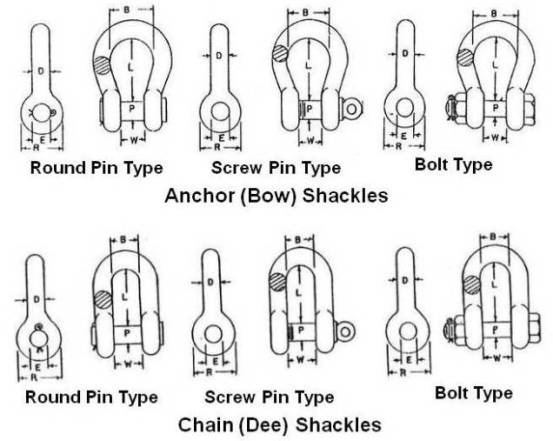
In USA, shackle specifications are defined by the following documents, depending on the shackle size:
For shackles 3/16 to 2 3/4 inches, the specifications are derived from Federal Specification RR-C-271, “Chains and Attachments, Welded and Weldless.”
For shackles 1 1/2 to 4 inches, the specifications are derived from MIL-S-24214, “Shackles, Steel, General Purpose and High Strength.”
For shackles 4 1/2 to 8 1/2 inches, ASTM A148M, “Standard Specification for Steel Castings, High Strength, For Structural Purposes,” should be used.
Note:
For the overlaps in size, with RR-C-271 and MIL-S-24214, either specification may be used; however, RR-C-271 is most commonly used. Catalogs and manufacturers’ literature will list the federal specification number as “RR-C-271(rev.).”
Two grades of shackles are made as per specification RR-C-271D.
Grade A shackles, together with their pins and bolts are forged from carbon steel. Grade B shackles together with their pins and bolts are forged from alloy steel.
Recommended safe working loads for these grades are as under.
| Recommended Safe Working Load (Maximum) in Pounds | |||||
|---|---|---|---|---|---|
| Size (D) inches | Grade A | Grade B | Size (D) inches | Grade A | Grade B |
| 3/16 | 520 | 900 | 1-1/4 | 16,500 | 36,000 |
| 1/4 | 710 | 2,000 | 1-3/8 | 19,800 | 41,400 |
| 5/16 | 1,060 | 3,120 | 1-1/2 | 23,740 | 48, 800 |
| 3/8 | 1,590 | 3,800 | 1-5/8 | 27,900 | 57,400 |
| 7/16 | 2,170 | 5,180 | 1-3/4 | 32,320 | 65,000 |
| 1/2 | 2,830 | 6,500 | 2 | 42,220 | 85,040 |
| 9/16 | 3,580 | - | 2-1/4 | 54,000 | - |
| 5/8 | 4,420 | 10,000 | 2-1/2 | 67,600 | 121,400 |
| 3/4 | 6,360 | 13,800 | 2-3/4 | 81,000 | - |
| 7/8 | 8,650 | 18,700 | 3 | 96,200 | 150,000 |
| 1 | 11,310 | 24,400 | 3-1/2 | 131,100 | 200,000 |
| 1-1/8 | 13,360 | 28,600 | 4 | 171,140 | 260,000 |
It may be noted that shackles are sized by the diameter of steel in the bow section rather than the pin size. The recommended safe working loads are for In-Line loading. In In-Line loading, load is applied perpendicular to pin. If load is to be applied at an angle, it must be applied in the plane of the bow as shown below.
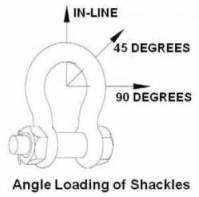
For side loading screw pin and bolt type shackles, safe working load shall be reduced as per following table.
| Angle of Side Load from Vertical (In-Line of Shackle) | Adjusted Working Load Limit |
|---|---|
| 0°, In-Line | 100% of Rated Working Load Limit |
| 45° from In-Line | 70% of Rated Working Load Limit |
| 90° from In-Line | 50% of Rated Working Load Limit |
However, shackles symmetrically loaded with two leg slings having a maximum included angle of 120° as shown below can be utilized to full Working Load Limit.
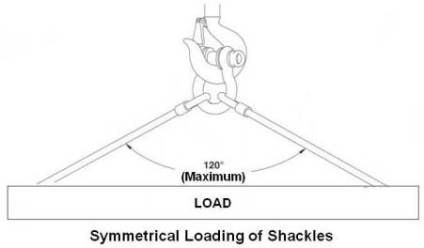
Design Factors:
Shackles manufactured in accordance with RR-C-271 and MIL-S-24214 have a minimum design factor of 5. Shackles manufactured to the requirements of ASTM A148M have a minimum design factor of 4.
Shackles for critical-lift service shall have an initial proof load test of two times the SWL (minimum). Before making a critical lift, ensure that the shackle has been proof tested.
ASME specification number for shackles is B30.26.
Specification number IS 6132: 2003, Forged Shackles for General Lifting Purposes – Dee Shackles and Bow Shackles is applicable in India. This Indian Standard is identical with ISO 2415: 1987 `Forged shackles for general lifting purposes – Dee shackles and bow shackles' issued by the International Organization for Standardization (ISO).
ISO 2415:2004 specifies the general characteristics of forged dee and bow shackles in a range of sizes having working load limits of from 0,32 t to 100 t and in Grades 4, 6 and 8, and presents their performance and critical dimensions necessary for their interchangeability and compatibility with other components.
Shackles by Crosby
In addition to normal shackles, Crosby makes two special types of shackles as under.
Wide Body Shackle
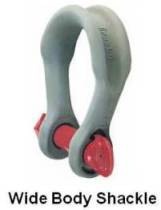
Use of wide body shackles increases sling bearing surface and eliminates need for a thimble. Due to higher D/d ratio, it also increases usable sling strength.
COLD TUFF® shackles
They are suitable for use to -50° F.
Application
Select type of a shackle as under.
Round Pin Shackles: They can be used in tie down, towing, suspension or lifting applications where the load is strictly applied in-line.
Screw Pin Shackles: They can be used in any application where a round pin shackle is used. In addition, screw pin shackles can be used for applications involving side-loading circumstances. Reduced working load limits are required for side-loading applications. While in service, do not allow the screw pin to be rotated by a live line, such as a choker application.
Bolt-Type Shackles: They can be used in any applications where round pin or screw pin shackles are used. In addition, they are recommended for permanent or long term installations and where the load may slide on the shackle pin causing the pin to rotate.
Useful Information on Use of a Shackle
The shackle pin shall never be replaced with a bolt; only a properly fitted pin shall be used. Bolts are not intended to take the load that is normally applied to the pin as shown below.
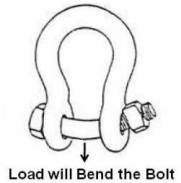
Centralize whatever is being hoisted on the pin by suitable washers or spacers as shown below.
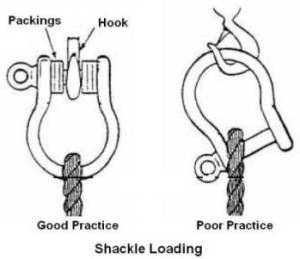
Screw pin shackles shall not be used if the pin can roll under load and unscrew as shown below.
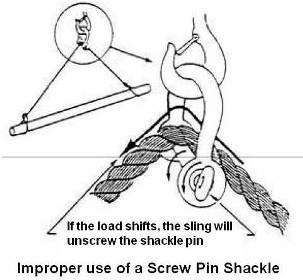
When using a shackle to make choker hitch, place pin in the eye of sling as shown below.
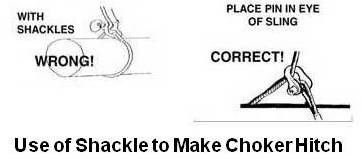
For more information like dimensions, finish, etc. please refer Crosby’s General Catalogue. Their website address is – http://www.thecrosbygroup.com
